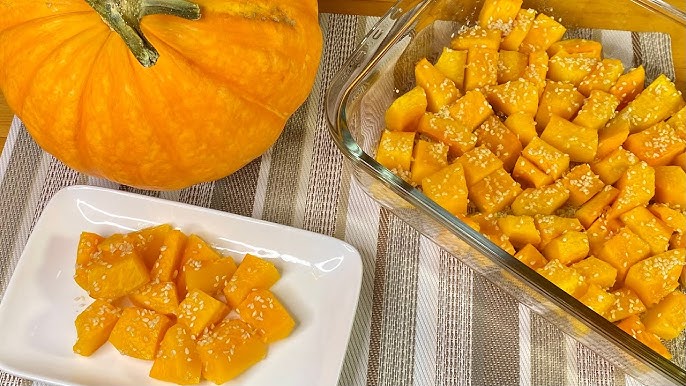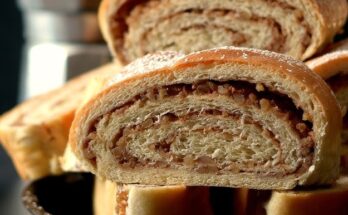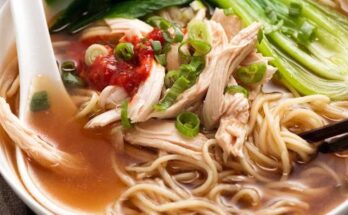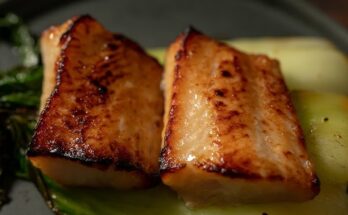Pumpkin Recipe: Pumpkin isn’t just a Halloween decoration—it’s a culinary hero of the fall season. From lattes to pies and soups to muffins, pumpkin recipes bring cozy comfort and seasonal flair to your table. The earthy sweetness and rich texture of pumpkin pair beautifully with warm spices like cinnamon, nutmeg, and cloves. Whether you’re an experienced home cook or a beginner in the kitchen, mastering a pumpkin recipe can add magic to your autumn meals.
But beyond the taste, pumpkin is loaded with nutrients—think vitamin A, fiber, and antioxidants. It’s low in calories and high in flavor, making it a guilt-free addition to your meal planning. Plus, it’s incredibly versatile. Whether you’re baking a loaf of moist pumpkin bread or whipping up a creamy pumpkin soup, there’s a recipe for every palate.
In this guide, we’ll walk you through everything—from the ingredients you need to a foolproof step-by-step process to make a perfect pumpkin dish. Ready to turn that orange squash into something delicious? Let’s dive in!
Ingredients You’ll Need
Before we get cooking, let’s gather all the ingredients. This pumpkin recipe is based on a classic pumpkin bread, but with tweaks you can adapt it for muffins, cake, or even pancakes.
Fresh vs Canned Pumpkin: What’s Best?
First things first—should you use fresh pumpkin or canned? Canned pumpkin is convenient, consistent, and available year-round. Just make sure it’s 100% pure pumpkin and not pumpkin pie filling, which has added sugar and spices.
Fresh pumpkin gives a lighter texture and deeper flavor but requires extra steps—peeling, roasting, and pureeing. If you have time, go for fresh. If not, canned works just fine.
Essential Ingredients for the Recipe
Let’s break down the ingredients into key categories so you can easily prep your shopping list.
For the Pumpkin Base:
- 1 ½ cups of pumpkin puree (canned or fresh)
- 2 large eggs (room temperature)
- ½ cup vegetable oil or melted butter
- ⅓ cup milk (dairy or non-dairy)
- 1 tsp vanilla extract
These are the wet ingredients that bring moisture and richness to the recipe.
For the Spices and Flavor:
- ¾ cup brown sugar (adds depth and moisture)
- ¼ cup white sugar (for balance)
- 1 tsp ground cinnamon
- ½ tsp nutmeg
- ¼ tsp ground ginger
- ¼ tsp cloves
- ½ tsp salt
Feel free to adjust the spices to your liking. Want a bolder flavor? Add more cinnamon or try pumpkin pie spice blend for convenience.
For Baking or Cooking:
- 1 ¾ cups all-purpose flour (or gluten-free blend)
- 1 tsp baking soda
- ½ tsp baking powder
These are your dry ingredients. Sift them if you want a fluffier texture.
Optional Add-ins for Extra Flavor
- ½ cup chopped walnuts or pecans
- ½ cup chocolate chips or white chocolate
- Dried cranberries or raisins
- A swirl of cream cheese for a cheesecake twist
You can get creative here. These add-ins enhance both flavor and texture, giving your pumpkin recipe that wow factor.
Kitchen Tools You’ll Need
You don’t need a fancy kitchen setup to make an amazing pumpkin recipe, but having the right tools makes things smoother and more enjoyable.
Basic Tools for Preparation:
- Large mixing bowl
- Medium mixing bowl
- Measuring cups and spoons
- Whisk or electric hand mixer
- Rubber spatula
- Loaf pan or muffin tin (depending on your variation)
These essentials will help you mix, measure, and combine everything with ease.
Useful Gadgets That Make Things Easier:
- Stand mixer (if you’re baking in bulk)
- Food processor (for fresh pumpkin puree)
- Sifter (for fluffier flour)
- Ice cream scoop (for perfectly even muffins)
Even though these aren’t mandatory, they do speed things up and can elevate your baking game. Especially if you’re making fresh puree, a good food processor is gold.
Step-by-Step Guide
Let’s get to the fun part—making the recipe! Follow these steps carefully for a perfect result every time.
Step 1: Preheat and Prep
Begin by preheating your oven to 350°F (175°C) if you’re baking, or prepare your stovetop or pan if you’re cooking another pumpkin dish. Grease your baking dish, loaf pan, or muffin tin with a bit of butter or non-stick spray. This ensures your pumpkin treat comes out smooth and golden, not stuck or burnt.
Step 2: Combine Dry Ingredients
In a large bowl, whisk together flour, baking powder, baking soda, salt, and your favorite pumpkin spices like cinnamon, nutmeg, and cloves. Mixing these first keeps your flavor even and your texture perfect—no random clumps of spice hiding anywhere.
Step 3: Mix Wet Ingredients
In a separate bowl, combine pumpkin puree, eggs, oil (or melted butter), sugar, and a splash of vanilla extract. Stir until the mixture is smooth and glossy. This step brings moisture and that deep pumpkin flavor we all crave.
Step 4: Blend Everything Together
Gradually add your dry ingredients to the wet mixture, stirring gently until just combined. Don’t overmix—keep it light and fluffy for the best texture.
Step 5: Bake or Cook to Perfection
Pour the batter into your prepared pan and bake for 45–60 minutes, or until a toothpick inserted in the center comes out clean. Cool slightly before serving. Enjoy warm with butter, cream cheese frosting, or a drizzle of honey!
Tips for Perfect Pumpkin Recipes
No one likes a dry loaf or bland muffins—so how do you make sure your pumpkin recipe turns out perfect every single time? Let’s break down some of the most important pro tips that even experienced bakers swear by.
1. Don’t Overmix the Batter
Once you combine the wet and dry ingredients, stir just until they’re incorporated. Overmixing is a one-way ticket to a dense, rubbery texture. You want tender, moist results—not a chewy, overworked loaf.
2. Use Room Temperature Ingredients
Eggs, milk, and even the pumpkin puree will blend more smoothly if they’re not ice cold. This helps your batter come together evenly and improves texture and rise during baking.
3. Let the Batter Rest
Give your batter 5–10 minutes to rest before baking. This short waiting time lets the flour absorb the liquids and gives you a better final structure. It’s a small trick with big results.
4. Monitor Your Oven
Ovens vary in temperature, even if they say 350°F on the dial. If you’ve had problems with baked goods in the past, consider using an oven thermometer. Also, rotate your pan halfway through baking for even browning.
5. Add Moisture Boosters
Want even more moisture? Add a tablespoon or two of applesauce, sour cream, or Greek yogurt to the wet ingredients. These can take your pumpkin bread from good to bakery-quality delicious.
6. Use High-Quality Spices
Old, dusty cinnamon and nutmeg from the back of your cabinet won’t deliver the same bold fall flavor. Make sure your spices are fresh for that irresistible warm, spicy kick.
7. Don’t Skip the Salt
It may seem small, but salt plays a huge role in flavor. It balances the sweetness and enhances the richness of pumpkin and spice. Never leave it out unless you’re on a low-sodium diet—and even then, just reduce it.
By following these tips, you’ll not only avoid common baking pitfalls but also elevate your pumpkin recipe to something worthy of your fall menu lineup.
Variations You Can Try
The beauty of a classic pumpkin recipe lies in how easy it is to customize. You can tweak a few ingredients and turn it into a new dish entirely. Here are some of our favorite variations you can experiment with:
1. Gluten-Free Pumpkin Recipe
Want to go gluten-free? Swap out the all-purpose flour with a 1:1 gluten-free flour blend. Most of these are formulated to mimic regular flour, so your texture stays light and moist. You may also add ½ teaspoon of xanthan gum if your mix doesn’t already contain it.
2. Vegan Pumpkin Recipe
Ditching animal products? No problem. Replace eggs with flax eggs (1 tbsp ground flaxseed + 3 tbsp water = 1 egg), and use non-dairy milk like almond or oat. Substitute oil for butter, and make sure your sugar is vegan-approved. The result? A tender, flavorful pumpkin loaf that’s 100% plant-based.
3. Savory Pumpkin Dishes vs Sweet Ones
Not in the mood for sweets? Try a savory spin. Reduce the sugar, skip the cinnamon and nutmeg, and add garlic powder, thyme, rosemary, or sage. Use this savory pumpkin mix as a base for pumpkin soup, savory muffins, or even pasta sauce.
Here are a few ideas for both categories:
Sweet Pumpkin Ideas:
- Pumpkin pancakes
- Pumpkin spice muffins
- Pumpkin cheesecake bars
- Pumpkin French toast
Savory Pumpkin Ideas:
- Pumpkin soup with coconut milk
- Pumpkin risotto
- Pumpkin and sage pasta
- Pumpkin curry
Whether you’re sweetening up your morning or prepping a cozy dinner, pumpkin’s versatility makes it a must-have ingredient for every kitchen.
Storage and Reheating
Made a big batch or saving some for later? Let’s talk about storing and reheating your pumpkin dish without losing flavor or texture.
How to Store Leftovers
- Room Temperature: If you plan to eat your pumpkin bread or muffins within 2 days, you can store them in an airtight container at room temperature. Make sure they’ve completely cooled before sealing them up.
- Refrigerator: For up to 5–7 days, refrigerate your pumpkin goods in a container with a paper towel to absorb excess moisture. This helps avoid sogginess.
- Freezer: Want to store for longer? Wrap your cooled loaf or muffins tightly in plastic wrap, then place in a freezer-safe bag. You can freeze them for up to 3 months. When ready to eat, thaw overnight in the fridge or at room temp.
Best Ways to Reheat Without Drying Out
- Microwave: Place a slice of pumpkin bread on a plate with a damp paper towel over it. Microwave for 15–20 seconds. This keeps the bread moist and soft.
- Oven: Wrap your loaf or muffins in foil and warm at 300°F for about 10–12 minutes. This method is great if you’re reheating multiple portions.
- Toaster Oven: Ideal for slices. Toast for 2–3 minutes for a slightly crisp outside and soft inside.
Tip: Spread a little butter, cream cheese, or nut butter on reheated slices for an even better bite.
Serving Suggestions
Pumpkin recipes aren’t just for breakfast or dessert. Here are some ideas for how to serve them at any time of the day—and make them the star of your table.
Pairings for Pumpkin Bread or Muffins
- Morning: Serve with hot coffee or a spiced chai latte. Add scrambled eggs or yogurt for a hearty fall breakfast.
- Afternoon Snack: Pair with fruit and nuts for a balanced pick-me-up.
- Dessert: Warm a slice and top with whipped cream or a scoop of vanilla ice cream.
Holiday Presentation Tips
- Garnish with a dusting of powdered sugar or a drizzle of glaze for a festive look.
- Serve on a wooden board with cinnamon sticks, fresh rosemary, or tiny pumpkins for a Pinterest-worthy display.
- Use muffin wrappers with seasonal designs or a bundt pan for a fancy twist on a classic loaf.
Whether you’re serving it at a holiday dinner or a cozy Sunday brunch, these touches turn your pumpkin dish into a centerpiece.
Nutrition Facts
Pumpkin isn’t just a delicious seasonal treat—it’s also packed with nutrients that make it a smart addition to your diet. Let’s break down the health benefits and what you can expect in a typical serving of homemade pumpkin bread or muffins.
Calories and Macros (Per Slice of Pumpkin Bread)
| Nutrient | Amount (Approx.) |
|---|---|
| Calories | 180–220 kcal |
| Carbohydrates | 30–35 g |
| Sugars | 15–18 g |
| Fiber | 2–3 g |
| Protein | 3–4 g |
| Fat | 7–10 g |
| Saturated Fat | 1–2 g |
Note: Values vary depending on specific ingredients used (oil vs. butter, add-ins, etc.)
Pumpkin is naturally low in calories and fat, making it a great choice for healthy eating. It provides a creamy texture without needing lots of butter or sugar, which is why it’s perfect for guilt-free indulgences.
Vitamins and Minerals in Pumpkin
- Vitamin A: Pumpkin is extremely rich in beta-carotene, which converts to vitamin A in the body. One serving can meet over 100% of your daily needs!
- Vitamin C: Supports immunity—especially helpful during fall and winter.
- Potassium: Aids in muscle function and helps regulate blood pressure.
- Iron: Boosts energy levels and supports red blood cell production.
- Antioxidants: Protect your body from free radicals and oxidative stress.
The bottom line? Pumpkin isn’t just tasty—it’s a powerhouse of nutrients, which makes this recipe not just satisfying but nourishing too.
FAQs about Pumpkin Recipe
1. Can I use pumpkin pie filling instead of pumpkin puree?
Nope—not recommended. Pumpkin pie filling has added sugar, spices, and preservatives that will throw off the balance of this recipe. Always use 100% pure pumpkin puree for best results.
2. What’s the difference between sugar pumpkin and regular pumpkin?
Sugar pumpkins (also called pie pumpkins) are smaller, sweeter, and less watery than the large carving pumpkins. If you’re using fresh pumpkin for cooking, sugar pumpkins are the best choice. Carving pumpkins are more stringy and bland.
3. Can I freeze the pumpkin bread or muffin batter?
Yes! You can freeze the raw batter in a sealed container or scoop it into muffin liners and freeze them unbaked. When ready to bake, let them thaw slightly and bake as normal, adding a couple extra minutes to the bake time.
4. How do I make it less sweet?
You can reduce the sugar in this recipe by ¼ to ⅓ without affecting texture too much. You can also use natural sweeteners like maple syrup or honey, but you may need to adjust the dry ingredients slightly to balance the moisture.
5. What toppings go well with pumpkin bread?
So many! Try cream cheese frosting, a maple glaze, chopped nuts, a cinnamon sugar sprinkle, or even a streusel topping. If you want a savory spin, skip the sugar and top with herbed butter or a cheese spread.
Conclusion
There’s just something about a warm pumpkin recipe that makes everything feel a little more comforting. Whether you’re making it for a lazy weekend breakfast, a cozy fall afternoon snack, or a festive holiday dessert, this step-by-step pumpkin recipe is easy to follow, delicious, and totally customizable.
You’ve got the breakdown—from ingredients and tools to mixing, baking, and storing. Plus, those extra pro tips and variations mean you can make this your own, no matter your dietary needs or preferences. Don’t be afraid to experiment, tweak, and add your own flair to this seasonal favorite.
So go ahead—grab that can of pumpkin (or roast your own!), preheat the oven, and make some magic happen in your kitchen. Your taste buds (and maybe even your neighbors) will thank you.



